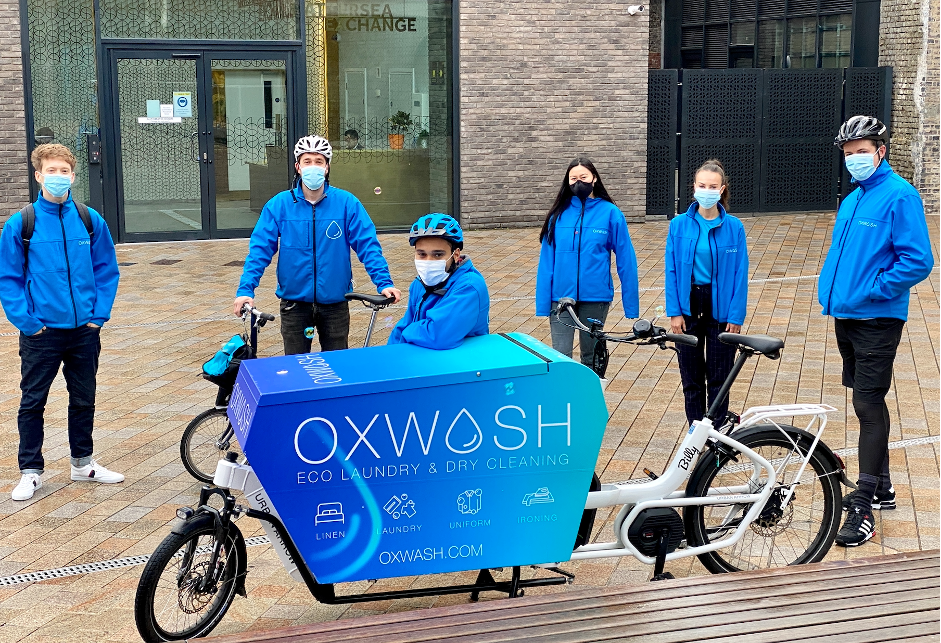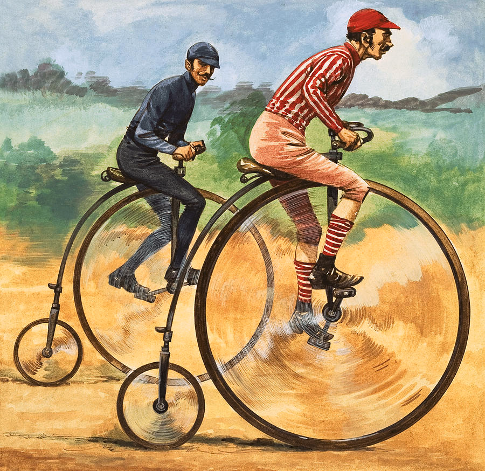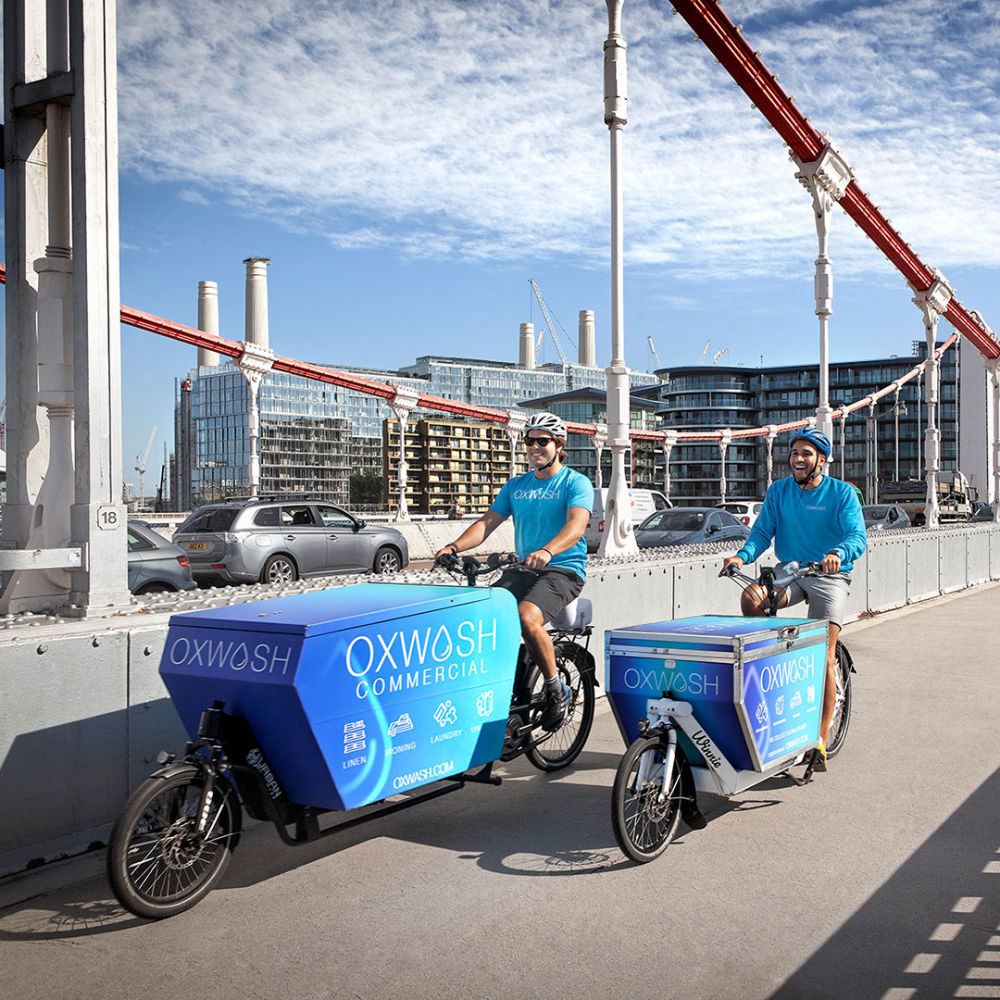Our sustainability report is now live and free to download!
eCargo-Bikes: Welcome to the Future
eCargo-Bikes: Welcome to the Future


Business & Insights
What is an e-Cargo bike?


Cargo-bikes have been around since the late 1800’s, even before the classic ‘Penny Farthing’. Remember that odd looking bike with one big wheel and one tiny one, tricycles were also very popular! Cargo-bikes were commonly used by artisan goods traders to transport their cargo, most notably milk and postal services. Our ancestors were geniuses were they not? In 1888 came about the first classic bike design called the ‘safety’ bike, due to it being closer to the ground than the ‘Penny Farthing’. This was designed by John Sterley.
The ‘Safety’ bike stood out as it was the first to utilise a chain. This new technique allowed freedom for position of the rider and cargo department, suddenly the addition of freight became dynamically interesting. This idea took up legs and ran, bikes were now being designed with a box at the front, rear and side of the frames. Between the rider and handlebars or the rider and the back wheel, designs were almost boundless. This led to the more recognised cargo-bike design today known as a ‘Long John’. A light, sturdy, narrow, and easily navigated cargo bike that contained a box. A box that can be up to 2m long, between the rider and front wheel, exactly like the cargo-bikes Oxwash use.
So, why did cargo-bikes lose popularity?
Unfortunately, in the rise of the urbanisation, cargo-bikes became a thing of the past. They were abandoned in the 1960s for the new bright and shiny pickup trucks, vans and cars. Consumer demands had changed, refrigerators decreased the need for fresh good deliveries, smaller households and an uptake in car usage made cargo-bike transportation obsolete.
Or so we thought...
Fast forward to the 20th century and well, what do you know! Cargo-bikes have re-appeared, we love repeating old trends do we not? As we have move forward as a civilisation our economic landscapes have changed. Our towns and cities have become increasingly populated and congested with traffic, the cargo-bike has found relevance again. Not only has it found relevance again, but it is colonising urban freight as we know it.


How are cargo-bikes changing urban freight?
Have you ever been stuck in a traffic jam when a bike messenger or courier flies by? We all get that little ball of hatred appear because they’re not stuck in traffic with us, that’s how cargo-bikes are changing urban freight forever. Convenience, time, money, and more recently environmental impact are major influencers for a business' choice of logistic transports and the cargo bike just conquered one of most important endurances - traffic.
"they can handle situations where a car previously seemed indispensable"
Cargo-bikes have proven to be just as fast, if not more, as other freight transport, namely trucks and cars. This is due to many reasons but mostly traffic. They can weave in out of traffic like a snake, dart down back allies, take routes that would otherwise be inaccessible to larger vehicles and drive fast during rush hour. Especially those that have gone with electrical powered cargo-bikes (ecargo-bikes). Making them the faster option.
They are financially more favourable, a cargo-bike costs a substantial amount less including, upfront costs (£4,000 to £9,000 compared to £20,000 for a van), maintenance, damage and pedal bikes cost a whole lot of nothing to run. Cargo-bikes even electric ones do not require fuel (just a charge-up), whereas a larger goods vehicle tend to drink petrol like its water.
Have I mentioned how convenient they are? Apart from the obvious time and money saved, they are also convenient space wise, for both company and personal use. Parking in busy cities is hard enough even with a small car, but bikes can park in the smallest of spots, have designated bike stations/racks and fold up to be stored inside. No hassle of driving around and around for a parking space.
Health is a big factor in choosing a cargo-bike, for the employee it has so much more added benefits: no more strained muscles on an ecargo-bike. It gives you exercise; it also reduces stress, raising the happiness of those riding. No one likes a stressed delivery driver, I think we have all been there, having happier and healthier employees will only have positive effects on a company.
Cargo-bikes are making the market more accessible for start-up and niche business such as Oxwash, as well as giving them a fighting chance against bigger conglomerates such as Amazon. Although we are looking forward to seeing their drone delivery system. The convenience of the ecargo-bike can help these companies that are out in the countryside, the power means they can tackle tougher grounds with no added toll to the rider.
One of the biggest advantages and selling points to The Cargo-bike is the reduced environmental impact.


Why are cargo-bikes better for the environment?
The use of motorised vehicles inflict or contribute to the 4 major pollutants; air, land, noise, and light. I was not aware so many types of pollutants exist, were you? The burning of fossil fuels in a car engine produces nitrogen oxide, sulphur oxide, carbon monoxide, carbon dioxide, and particulates (road and tire ware). The fall out of these and other volatile organic compounds (VOCs) are toxic and carcinogenic, as classed by the World Health Organisation. VOCs have also been proven to irritate breathing conditions and cause lung and respiratory diseases. Vehicles also produce large amounts of noise and artificial light which alter surrounding environments . This air pollution leaves our atmosphere dirty and unable to regulate its temperature leading to climate change.
Together, these pollutants alter and damage the temperature, light, noise, and composition of our delicate ecosystem. It changes specie and biome distribution and leads to species extinction. Climate change is melting our polar ice caps and endangering many aquatic inhabitants. Acid rain from the Sulphur oxide and water kills many animal taxa as well deforestation. Our insect pollinators are being made blind, unable to feed or pollinate and some fauna are simply dying and human life expectancy is dropping dramatically. There is a need to turn the tide on our growing pollution problem, and inventions like the cargo-bike are just what we need to do that.
Cargo bikes emit no hazardous gases and almost non-existent noise and light pollutants. You can see why they are so popular? Although electric cargo-bikes do emit some gases it is remarkably lower and have a far lower carbon footprint for manufacture. Both types of cargo-bikes however produce wear-and-tear particulates. But again this is at exceptionally low levels compared to traditional road vehicles. Cargo-bikes can thus enter Clear Air Zone (CAZ) and Ultra Low Emission Zones (ULEZ), like those set up in London, free of charge unlike vans, lorries, or cars. There are even incentives in place for companies who want to switch to Low Energy Vehicles such as cargo-bikes with governments offering grants. What more could you want?


Nevertheless, our freight savour does have some drawbacks. Penalty costs are a real concern for companies, a loss of demand due to the weight, volume and distance limitations are a disadvantage in comparison. Safety is another drawback to the cargo-bike. Especially in the urban setting where the rider is vulnerable on the road, they are often less visible to large vehicle drivers. Additionally, they are susceptible to weather conditions which jeopardise the rider and the cargo if not properly addressed with weather gear and adequate lighting.
Cargo load is another concern, although with ecargo-bikes this is mostly ruled out, they cannot carry as much load as a van. Heavier weights in turn effects the distance they can travel. Such operational limitations decrease their business range and applicability.
Despite the disadvantages, they have proven their value and worth as a sturdy contender, if not winner in the race for last mile logistics. The eco benefits speak for themselves! It is no wonder companies such as ourselves have adopted this transport lifestyle since day one and still don’t have any other kind of vehicle in our fleet.
Will your company be a cargo-bike convert?
Oh and did I mention they can also act as a walking billboard… but that’s a post for another time…
Related Articles


B Corp™ certified.


Surpassing NHS-grade disinfection.














